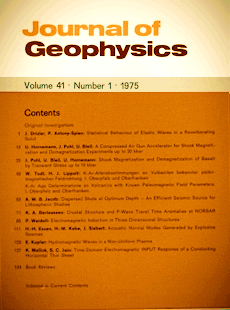Crustal structure of the Aegean Sea and the Hellenides obtained from geophysical surveys
Article Sidebar

Vols. 1-18 (1924-1944), ISSN 0044-2801
Main Article Content
Abstract
In the period 1971 to 1974 the territory of Greece has been geophysically investigated by Greek and German Institutions. Gravity and magnetic stations have been distributed at a spacing of one station per 25 km2. Five deep seismic sounding cross-sections have been fired and recorded along the lines: Ionian Sea — Peloponnese, Amorgos — Mikonos — Evia, Crete: East-West, Cretan Sea: North-South, Cretan Sea: East-West. The results of the seismic programms revealed a pure continental structure of variable thickness. The most attenuated area is that of the Cretan Sea, with only 22 km depth to the Moho-Discontinuity at the Bouguer gravity maximum of +175 mgal. The very unevenly distributed sedimentary cover of the Cretan Sea is composed mainly of Neogene Sediments with thickness of 3–3,5 km in local basins (Jonsma et al., 1975). The Greek mainland along the Pindos Chains has minimum Bouguer anomalies of –120 to –140 mgal and Moho-Depths between 42–46 km. The Aegean Area builds a large dome and incorporates also a large part of the Taurides, Western Turkey (Makris, 1975).
 ARK: https://n2t.net/ark:/88439/y049082
ARK: https://n2t.net/ark:/88439/y049082
Permalink: https://geophysicsjournal.com/article/153
Article Details
References
Hinz, K. (1974) Results of seismic refraction and seismic reflection measurements in the Ionian Sea. Geol. Jahrb., E. 2:33-65
Makris, J. (1973) Some geophysical aspects of the evolution of the Hellenides. Bull. Geol. Soc. Greece, X:206-213
Makris, J. (1975) Geophysical investigations of the Hellenides. Hamb. Geophys. Einzelschriften, Heft 27:1-98 (in print)
Makris, J., Mavridis, L.N., Menzel, H., Stavrou, A. and Veis, G. (1973) The gravity field of Attika, the Peloponnese and Kithera, Greece. Z. Geophys. 39:929-936
Makris, J., Koschyk, K., Vees, R. Refraction seismic measurements along the lines: Crete East-West, and Amorgos-Mikonos-Evia. In preparation
Weigel, W. (1974) Crustal Structure under the Ionian Sea. J. Geophys. 40:137-140











